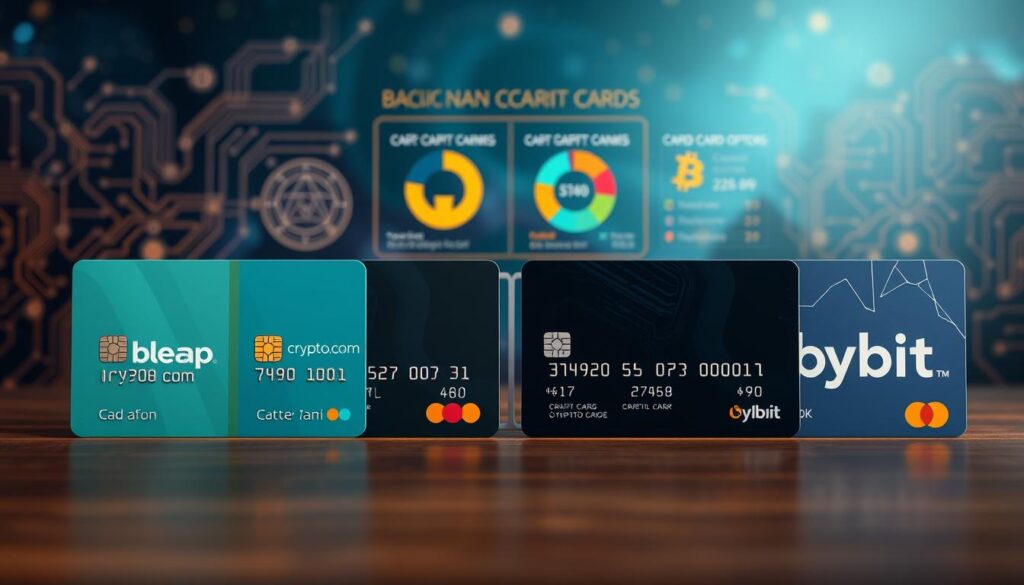Now Reading: Crypto Cashback Rewards Platforms Comparison: Best Options
- 01
Crypto Cashback Rewards Platforms Comparison: Best Options
Crypto Cashback Rewards Platforms Comparison: Best Options

This guide maps the real value behind headline offers so U.S. readers can pick the right payment and earning mix for daily use. We cover cards, exchange fee rebates, and shop-to-earn apps to give a full view of the rewards landscape.
Not all advertised rates mean more money in your pocket. High percentages can be offset by FX markups, staking locks, or volatile token payouts. We introduce an effective retained value approach to show net outcomes after fees and market swings.
Expect quick picks and side-by-side checks: Bleap’s Mastercard with 2% USDC and no FX fees, higher-rate offers like Crypto.com with staking limits, and exchange rebates on Binance, OKX, Gemini, and Bybit.
We’ll score each option on rewards rate, fee structure, custody model, accessibility, security, and usability. The goal is to help users match a product type to spending habits, trading activity, and risk tolerance — not just chase the biggest number.
What to compare right now: rewards, fees, and real value in the present market
Headlines often hide the costs that shrink what you actually keep. Start by matching offers to clear U.S. goals: net value on daily payments, low custody friction, and straightforward tax treatment. Beginners should favor flat rebates, sign-up bonuses, and simple card cashback. Advanced users may chase VIP tiers, staking boosts, or maker rebates.
Effective retained value is our benchmark. It subtracts the fee stack—card fee, FX fee, conversion fee, top-up fee, and withdrawal fee—and factors token volatility and spreads. Stablecoin payouts limit volatility, while native tokens can swing before redemption.
Which rates matter? Base rates that apply to all categories beat niche boosts if you spend outside bonus categories. Monthly spending variability also determines whether tier thresholds are feasible.
- Fee stack: small percentages compound and can erase gains.
- Fiat conversion: markups vary by issuer and hit cross-currency payments hard.
- Access: Apple/Google Pay, card issuance, and domestic acceptance shape real usability.
Throughout this guide we use effective retained value so U.S. users choose options that reflect what they actually keep. See a deeper look at how token payouts compare to traditional cash via this side-by-side analysis.
Methodology for a crypto cashback rewards platforms comparison
To judge offers fairly, we converted diverse payout types into a single net value per dollar spent. That normalization makes cards, exchanges, and shopping apps comparable under one metric.

Data sources and verification
Current market data came from issuer docs, public fee schedules, VIP tables, and third-party analyses. We cross-checked card terms, exchange fee pages, and app payout policies. Where U.S. availability was restricted, we flagged it in scoring.
Scoring pillars and modeling
Scores balance five pillars:
- Raw rewards rate — headline payout before costs.
- Fees / FX — conversion markups and recurring costs.
- Custody risk — counterparty and withdrawal limits.
- Geographic access — U.S. support and merchant coverage.
- Daily usability — card form factor, Apple/Google Pay, and app UX.
We modeled month-based tier thresholds against typical spending patterns. Payouts assume stablecoin vs native token delivery and include a volatility adjustment and an opportunity-cost charge for tokens staked to unlock higher tiers.
Quick picks at a glance: best crypto cards vs exchange rebates
Pick a daily option that actually increases your buying power, not just a bigger percentage on paper. Below are practical top picks based on net value, access, and usability for U.S. users.

Best everyday spending card
Bleap Mastercard — 2% in USDC with zero FX or conversion markups. It adds value for routine spending and offers $400/month free ATM withdrawals. Non-custodial MPC security plus Apple/Google Pay and global acceptance make it easy to use daily.
Best headline-rate card for stakers
Crypto.com Visa — top headline rates up to 5% if you lock CRO. That yield can beat flat cards, but FX, top-up fees, and tier limits reduce real monthly value for many users. Evaluate your holdings and risk tolerance before locking tokens.
Best option for active traders
Binance, OKX, and Bybit VIP tiers reward volume with lower taker fees and maker rebates. High-volume traders should model fee savings versus card-based benefits before choosing a payment card as their primary tool.
- Stablecoin payouts typically preserve purchasing power better than volatile token transfers for day-to-day use.
- Partner perks (think amazon prime-style bundles) can add value but rarely offset big FX markups.
- Compare a flat 2% net card month-to-month against tiered offers that need ongoing holdings to stay competitive.
Card showdown: Bleap vs Crypto.com vs Gemini vs Bybit
When you line the major issuers side by side, differences in payout type and fees become obvious fast.

Cashback rates and payout type
Bleap pays 2% in USDC, a stable payout that avoids token swings. Crypto.com, Gemini, and Bybit pay in native tokens or variable crypto that can move before you convert.
FX and conversion impact
Bleap has no FX or conversion fees, so net yield stays close to the headline rate. Other issuers often apply a 1–3% spread or top-up fee that can erase higher headline numbers.
Custody, security, and withdrawals
Bleap uses non-custodial MPC for stronger user control. Crypto.com, Gemini, and Bybit are custodial, which raises counterparty risk and may limit withdrawals.
Daily use and limits
Bleap offers free ATM withdrawals up to $400 per month and broad Apple/Google Pay support. Bybit and others restrict access regionally or charge inactivity and conversion fees.
- Who wins: fee-free daily spenders — Bleap. Stakers who accept CRO lockups — Crypto.com.
Exchange rewards face-off: Binance, OKX, Bybit, and Crypto.com
Volume, maker/taker role, and token holdings together shape the real net benefit of an exchange plan.

Fee rebates work by tracking 30-day volume and order type. Makers who add liquidity often get lower fees and sometimes positive maker rebates. Takers pay higher rates unless volume or VIP status reduces them.
VIP tiers on Binance, OKX, and Bybit are month-based. Moving up needs realistic monthly volume or fee-paid status. Top tiers cut taker fees sharply and can turn maker activity into net gains.
- Staking or holding BNB, OKB, or CRO cuts fees and unlocks boosts, but it adds price risk to your holdings.
- Referral bonuses and missions give native tokens for deposits, trades, or simple tasks — useful for beginners building balances.
- API and algorithmic trading can generate repeat maker volume to qualify for rebates, helping low-margin strategies scale.
| Exchange | Typical month volume needed | Token boost | Payout currency |
|---|---|---|---|
| Binance | $250k–$1M for meaningful tier | BNB staking reduces fees | USDT / BNB |
| OKX | $200k–$800k | OKB holdings raise tier | USDC / OKB |
| Bybit | $150k–$700k | Token locks cut maker fees | Stablecoins / native token |
| Crypto.com (exchange) | $100k+ plus CRO stake | CRO staking for VIP perks | CRO / stablecoin |
Check payout currency: stablecoin rebates preserve buying power, while native token payouts expose you to price swings at conversion. Also weigh liquidity, proof-of-reserves, and custody risk before leaving large holdings on any exchange.
When an exchange wins: choose it if you run consistent maker activity or automated strategies that produce steady volume. Otherwise, card-style flat payouts often remain simpler and more predictable.
Shopping and rebate apps compared: Lolli, Pei, StormX, CoinRebates, BitcoinRewards
Rebate apps differ in how and when they pay, so pick one that fits your spending rhythm.
Payout methods and frequencies
Lolli focuses on BTC payouts via a Chrome plugin and posts earnings after store confirmation. Pei links your card and pays USD or BTC via points accrual. StormX uses in-app tokens (Bolts) from microtasks and shopping; you convert them to withdrawable crypto.
Frequencies vary: instant tracking, weekly or monthly processing, and minimum thresholds can delay withdrawal. Track month-based totals to avoid leaving small balances stranded.
Store coverage and categories
CoinRebates and BitcoinRewards list big-box retail, travel, apparel, and online education partners. Lolli covers hundreds of stores with up to 10% in BTC. StormX can show high percent boosts during limited promotions.
Mobile vs browser plugins
Browser plugins like Lolli suit desktop shoppers. Mobile-first apps such as Pei and StormX work for on-the-go purchases and linked-card tracking.
| App | Payout currency | Typical frequency | Top stores |
|---|---|---|---|
| Lolli | BTC | Post-purchase confirmation (weekly) | Major retailers (hundreds) |
| Pei | USD or BTC | Monthly (points conversion) | Retail, grocery, food delivery |
| StormX | In-app tokens → crypto | Instant tracking / weekly conversion | Apps, marketplaces, niche stores |
| CoinRebates / BitcoinRewards | Multi-crypto / stablecoins | Weekly to monthly | Walmart, Macy’s, Expedia, Udemy |
Tip: Always read retailer fine print and confirm tracker hits at checkout. Do due diligence to avoid scams and protect your payment data.
Headline cashback vs real return: the math that actually matters
Before you chase a top-line percentage, run the math that shows net value in your wallet. Headline rates ignore FX spreads, conversion charges, and token swings that change the effective retained value.
FX spreads and conversion mechanics
FX markups are added by issuers when you pay in a foreign currency. A 2–3% spread on top of a 3% advertised rate can reduce that gain to near zero.
Conversion fees also stack when funding a card, settling transactions, and redeeming payouts. Those steps compound and cut effective yield.
Token volatility and lock-up opportunity cost
When rewards arrive as native tokens, their price can fall before you convert. That volatility can erase headline gains fast.
Staking lock-ups (for example to access CRO tiers) add opportunity cost. Locked holdings may miss market moves and reduce month-to-month flexibility.
Simple example and quick checklist
Example: spend €1,000 abroad.
Platform A: 3% headline minus 2.5% FX markup = net +0.5% (€5).
Bleap-style card: 2% headline with 0% FX = net +2% (€20). That is four times the real euro value.
- Fiat note: stablecoin or fiat settlement avoids extra conversion steps and simplifies realization.
- Issuer spreads: Visa/Mastercard networks don’t set issuer FX policy — your card issuer does.
- Yield view: a steady 2% net with no volatility is a repeatable, high-quality yield versus speculative APYs.
Quick math checklist: add FX markup + fee stack, subtract from headline rate, adjust for token volatility and lock-ups, then decide if maintaining holdings for tier eligibility still makes sense.
Beginner vs advanced users: choosing the right reward system
Start by matching product complexity to how much time you want to spend managing earnings.
Low-risk options for new users favor flat, predictable returns. A 2% card with no FX markup and clear sign-up bonuses gives steady value without staking or lock-ups.
Choose apps with simple UX and transparent payout thresholds. Avoid locked token holdings and volatile payouts until you understand tax and market risk.
When advanced tactics make sense
VIP tiers, staking, and market maker programs pay off for users who run consistent monthly volume and automated maker-heavy strategies.
- Consider an exchange route if you have steady 30-day volume and can use APIs to generate maker orders.
- Use staking to boost returns only after sizing positions and diversifying holdings to limit downside.
- Track effective cost per trade net of rebates; maker rebates can turn fees into income if you have scale.
Decision rule: simple card for daily spend; exchange rebates for traders; shopping apps to stack savings on focused purchases. Revisit your set-up every quarter as tiers, fees, and yields change.
Costs, limits, and fine print that change your net rewards
Small monthly charges and hidden conversion spreads can turn a promising headline into a near-zero net gain. Read issuer terms before you assume a rate is real cash in your pocket.
Common fee types include FX/conversion spreads, top-up fees, inactivity fees, withdrawal charges, and optional subscription costs. Even a $3–$10 monthly subscription or a 1–2% spread on foreign purchases can erase expected gains.
Entry requirements and token locks
Higher headline rates often require staking or holding native tokens such as CRO. These requirements limit flexibility and expose your holdings to price swings. Plan rebalancing if you must maintain positions to keep a tier.
Regional limits, conversion rules, and exclusions
Visa issuance, ATM policies, and withdrawal limits differ by region. Some issuers delay conversions to stablecoin or cash and impose minimum withdrawal thresholds. Purchases via excluded checkout flows may not qualify for payouts.
- Pro tip: compute a monthly breakeven: add all fees and spreads, then compare to your expected cashback from purchases.
- Prefer clear fee schedules and responsive support to resolve tracking or payout disputes fast.
| Fee type | Typical impact | What to check |
|---|---|---|
| Conversion / FX | 1–3% per purchase | Issuer FX policy |
| Top-up / subscription | $0–$15 / month | Auto-renew and cancel rules |
| Withdrawal / inactivity | Flat or percent charge | Minimums and delays |
Risk, red flags, and taxes: protect your cash and crypto
Look past flashy APYs to see whether the payout can actually be accessed and converted. Scan terms for lock-ups, withdrawal minimums, and payout currency before you commit holdings or link a card. Small print often changes what you can realistically realize.
Overvalued native tokens, unrealistic APYs, and withdrawal traps
Watch token economics. Some issuers prop value with marketing and buybacks. If the native token collapses, reported rewards vanish with it.
Question sky-high yields. Daily or perpetual APY claims can signal opaque mechanics or unsustainable offers. Treat them as red flags.
Beware withdrawal traps. Minimum thresholds, delayed unlock windows, and conversion bans can block access when you need cash.
Tax treatment in the US: income at receipt, potential capital gains
Most rewards, cashback, and referral bonuses count as taxable income when received. Track fiat value at receipt and date per item.
Later sales trigger capital gains or losses. Keep month-by-month records to simplify reporting and avoid surprises.
| Risk | Impact | Action for users |
|---|---|---|
| Overvalued token | Loss of payout value | Limit token exposure; prefer stable payouts |
| Unrealistic APY | Unsustainable scheme risk | Verify mechanics; read fee and lock-up rules |
| Withdrawal limits | Liquidity blockage | Check minimums and unlock timings |
| Custody risk | Paused withdrawals in stress | Favor proof-of-reserves and non-custodial options |
Your next move: a practical checklist to maximize cashback rewards
Start with a reliable payment card and build a stack around your monthly habits. For most U.S. users, a steady 2% stablecoin card with 0% FX like the Bleap Mastercard will boost net value on everyday purchases.
If you trade: compare maker/taker tables, VIP thresholds, and referral missions on your exchange before chasing tiered rebates. Only add complexity when it clearly improves your month-to-month net.
Add a shopping app layer like Lolli, StormX, or CoinRebates for select merchants and promos. Watch payout frequency, minimums, and amazon prime–style offers so small balances don’t get stuck.
Verify the fee stack: check FX, conversion, top-up, subscription, and withdrawal rules in the fine print. Consider staking only if CRO or other token holdings fit your risk and liquidity needs.
Track monthly: log payouts, fiat value at receipt, and pending withdrawals. Keep emergency cash and avoid locking all holdings for perks. Re-run your effective retained value math every quarter and switch if net outcomes slip.
FAQ
What are the main factors to compare when choosing a crypto cashback card or exchange rebate?
Compare the effective reward rate after conversion and FX spreads, any subscription or card fees, custody model (custodial vs self-custody), payout token (stablecoin vs native token), and geographic access. Also check usability features like Apple/Google Pay, ATM withdrawals, and merchant acceptance to understand real monthly value.
How do I calculate the real retained value versus the headline percentage?
Start with the advertised percent, subtract FX/conversion markup and any instant sale fee, then adjust for token volatility or staking opportunity cost if rewards come in a native token. Factor in subscription or staking requirements that reduce net yield. Example: a 3% headline rate minus 2.5% FX markup yields ~0.5% net before taxes and withdrawal fees.
Are stablecoin payouts better than native token rewards?
Stablecoins like USDC provide predictable purchasing power and simpler tax treatment at receipt. Native tokens can offer higher headline rates but add price risk and often require lock-ups to get top tiers. For low-risk users, stablecoin payouts usually deliver clearer, more usable value.
Which cards or exchanges offer the best everyday return with low fees?
Look for cards that pay a flat, no-FX percentage in USD or USDC and have minimal monthly or annual fees. The Bleap Mastercard-style product that pays 2% USDC with no FX spread is a model for everyday simplicity. On exchanges, VIP tiers on Binance or OKX can yield meaningful fee rebates for high-volume traders.
How do staking or token lock-ups affect reward eligibility and net yield?
Staking or lock-ups often unlock higher headline rates but reduce liquidity and create opportunity cost. Calculate the annualized return lost by locking funds and compare to the extra payout you receive. Also confirm unstaking windows and penalties, which can reduce effective yield.
What fees should I watch that commonly erode net returns?
Watch conversion/FX spreads, on-ramps (card top-up) fees, withdrawal costs, inactivity or subscription charges, and ATM withdrawal limits. Even small percentage spreads on frequent purchases can cut rewards dramatically over a month or year.
Are exchange fee rebates and VIP tiers worth pursuing for average users?
For high-volume traders, VIP tiers on Binance, OKX, and Bybit can reduce trading costs and return maker rebates. Average users often won’t hit volume thresholds; they may get more practical value from a simple card or shopping rebate app that pays in BTC or stablecoins without complex requirements.
How do shopping rebate apps differ in payout and coverage?
Apps like Lolli, Pei, and StormX vary by payout method (BTC, stablecoins), payout frequency, and minimum thresholds. Some work via browser plugins with wide store coverage; others are mobile-first with select merchants. Check store categories, payout timing, and withdrawal limits before committing.
What are common red flags and risks to avoid?
Beware overvalued native tokens used to inflate rewards, unrealistic APYs, mandatory long lock-ups, and sudden policy changes. Also watch custody risk—platforms that commingle funds or lack clear insurance increase exposure. Read terms around withdrawals and merchant disputes.
How is reward income taxed in the United States?
In the US, rewards received in tokens or stablecoins are generally treated as ordinary income at the fair market value at receipt. Later sales may trigger capital gains or losses. Keep detailed records of dates, values, and conversions to report accurately.
What should beginners prioritize versus advanced users?
Beginners should choose low-complexity options: flat rebates in USD/USDC, no-FX cards, and easy-access apps. Advanced users can benefit from VIP tiers, staking, and market maker programs if they understand volume requirements, tax implications, and custody trade-offs.
Can fees and FX spreads turn a higher headline rate into a worse deal?
Yes. A higher nominal percentage paid in a volatile native token or subject to a 2–3% FX markup can end up netting less than a smaller flat USD/USDC payout once conversion and volatility are accounted for. Always model net value per month.
How often are rates and promos updated, and how should I verify current offers?
Rates and promotions change frequently. Verify directly in the issuer’s app or official website, check recent user reports, and confirm any time-limited sign-up bonuses. Use multiple sources and note the date when comparing offers to maintain accuracy.
What practical checklist should I follow before applying for a card or signing up with an exchange?
Confirm payout token and frequency, fee schedule, FX spread policy, custody and withdrawal terms, geographic availability, Apple/Google Pay support, and any staking or subscription requirements. Compare sample monthly scenarios to estimate net yield.












